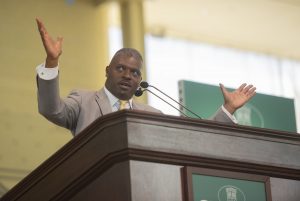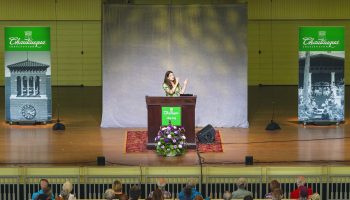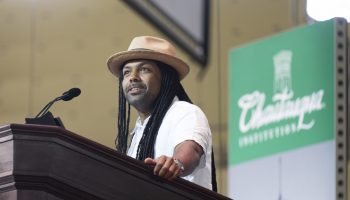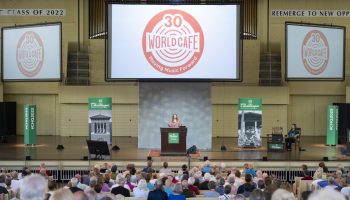
Hailed as a hero in the “Boston Miracle,” the Rev. Jeffrey Brown helped launch a movement that decreased youth crime rates in Boston by 79%. The way he did it was radical at the time — he went straight to the source.
To share his experiences, Brown, pastor and co-founder of Boston TenPoint Coalition, spoke at the 10:45 a.m. morning lecture Tuesday, July 2 in the Amphitheater, continuing Week Two’s theme, “Uncommon Ground: Communities Working Toward Solutions.”
When Brown first became a pastor, he wanted to serve in a megachurch.
“I wanted a 15 to 20,000-member church,” Brown said. “I wanted my own television ministry. I wanted my own clothing line. I wanted to be a long-distance carrier. You know, the whole nine yards.”
After a year, his church only grew by 20 members, and he realized his dream was farther away than he anticipated. In the meantime, Brown simply wanted to be a “good pastor.”
“I wanted to be with people through all of the passages of life,” he said. “The birth of children, who grow, go to school. To be with families through all of the crises of life; when someone gets sick, to go to a hospital and to visit them and to be there for the final transitions when the matriarchs and the patriarchs pass on, and you gather a family together to remember a life well lived.”
As Brown was embarking on the path “God called him to,” the homicide rates in his Boston community increased dramatically.
“There were young people who were shooting and killing each other for reasons I thought were very trivial,” he said. “Someone stepping on someone’s sneaker in a high school hallway and after school, instead of fisticuffs, someone would get shot.”
It occurred to Brown that he had a congregation at his disposal. He started to preach against the violence and began developing programs in the church he hoped would bring in at-risk youth. At the same time, he was encouraging other pastors to do the same.
“I thought, ‘this is our contribution to the problem, and if we have enough people to do it for long enough, then perhaps we will stem the tide of violence,’ ” Brown said.
But Brown’s efforts fell short, and the violence started to “spiral out of control.”
“The city of Boston experienced, out of 700,000, 152 homicides and 1,100 gun shootings that year,” he said. “Which means the violence was not just focused on those who were out on the streets, but also on folks who had absolutely nothing to do with the violence.”
The violence was so bad that it started to change the character of the city. Gunfire rang like fireworks every night and consequently, hospitals filled with victims of the crimes. Brown realized he was aiding families in the passages of life like he had always dreamed, but not for the matriarchs and patriarchs he had envisioned.
“I was also doing funerals of 18-year olds, 17-year olds and 16-year olds,” he said. “I was standing at the pulpit of a church or a funeral home, struggling to say something that would make a difference.”
Then came the moment Brown said he “will never forget.” At a community meeting about the violence, a woman stood up and said it was caused by a “lost generation.”
“Her solution was this: We need to take the time, talent and resources and plow them into the generation coming up, because this generation that is experiencing this violence is a lost generation,” Brown said.
When Brown left the meeting, two problems occurred to him: First, how can a community survive without an entire generation? Second, even if the community decides to take its time, talent and resources and concentrate them on youth, a generation was still being lost.
“I realized that (her solution) wasn’t the answer,” he said. “So the question was, ‘what is the answer?’ ”
Brown recalled a story of a boy named Jessie. Jessie had bought a brand new leather jacket and when two boys tried to take it, Jessie resisted. They killed him. As Jessie was running away, an eyewitness said he was running toward Brown’s church and died 150 yards in front of the building.
“Not to say he was trying to get to the church, but if he would have gotten to the church, it wouldn’t have made any difference because the lights were out and nobody was home,” Brown said. “When I got there later on and they told me the circumstances of what happened, it was an image that I could not get out of mind. The young man in desperate need of help, but the church would not have been there to help him because there was nobody there.”
A few days later, police caught some of the people involved in the murder, and Brown was shocked to find out they were only a few years younger than him.
“These young men who had done this deed were part of my own generation, but I knew nothing of the world they lived in,” he said.
As Brown contemplated what had happened in his city, a “funny kind of paradox” started to emerge. The paradox was that Brown’s definition of community was excluding the people committing the crimes.
“If I really wanted the community that I was seeking and praying for, I needed to redefine my sense of community and reach out and embrace those I had cut out of that definition,” Brown said.
Brown said that meant not only creating programming for at-risk youth, but engaging those who were committing the acts of violence. However, as soon as he came to that conclusion, another question occurred: “Why me?”
“As soon as that question came up, the answer came back just as quickly,” he said. “Why me? Because I’m the one who can’t sleep at night. Because I’m the one looking around saying, ‘Somebody needs to do something about this,’ and I’m starting to realize that someone is me.”
Just as Brown was finding his individual purpose, an incident occurred that brought the entire community together. Brown called this moment “the morning star.”
During a funeral at the Morning Star Baptist Church in Boston, a young man entered the room. A gang across the street from the church knew him as a member of a rival gang and they ran in after him. The gang started shooting and stabbing the boy in front of the altar.
The pastor at the funeral went on the radio that night and said a line had been crossed, and that the community of faith in Boston needed to come together.
More than 350 clergy members came from around Boston to meet with the pastor. They gave “eloquent speeches” and decided to meet the next Tuesday to talk about what actions could be taken. They did that again and again until nine Tuesdays had passed; only seven clergy members were showing up and zero action had been taken.
At the last meeting, it was recommended that the clergy members break off into committees. Realizing the answers did not lie within the four walls of his sanctuary, Brown made the decision to “meet the youth where they were at,” on the streets. Thus, a street committee formed.
The street committee met in Four Corners, the most violent neighborhood in Boston. Every night from 10 p.m. to 2 a.m., the committee would walk the streets, observing the activity around them. At first, Brown said people just stared at them, but eventually, they started to approach the group.
“Then we did an amazing thing as preachers,” he said. “We decided to listen and not preach.”
As Brown listened, he realized he had many misconceptions about the youth in his community.
“What we discovered was our perception was being colored by the 11 o’clock news or by the popular culture of the day, the music, the movies,” he said. “The reality was very, very different.”
The first misconception was that the youth were materialistic.
“We thought these kids were completely materialistic and that all they wanted was clothing and jewelry, ‘the bling,’ as they would call it,” he said. “But we found out that these kids were no more, no less bitten by the consumer bug than we are.”
The second misconception was that the kids would never want to talk about faith.
“I have had some of my most profound theological discussions, not in the hallowed halls of a seminary, but on a street corner at 1 a.m.,” he said.
Brown recalled a story in Four Corners when the committee tried to get people to stop selling drugs in a local park. There was a fence that separated the park from the street and there was always a boy at the door of the fence to let the pastors in and out. He never spoke, until one day he asked to speak to Brown’s friend, Bob.
At the end of the night, everyone asked Bob what the boy said.
The boy told Bob that out of all the things he had done in his life, he seemed to have lost his conscience and needed help getting it back.
“Imagine walking out with your friend, late at night, shots ringing out, a boy gets hit, you watch the life drain out of his body and you’ve got questions,” Brown said. “Where is he going? What are we doing in all of this? Can we ever get out?”
According to Brown, that is where the movement began — when he saw that people could find common ground through dialogue. Realizing he needed more than the help of other clergy members, Brown created a partnership with the Boston Police Department.
“If you know anything about the City of Boston and its history of race relations, you should know it is no small thing that you have black and Latino pastors coming together with white, Irish, Catholic police officers.”
Brown said the partnership started with the gang unit officers patrolling the streets. The officers started reaching out to clergy members to hear their perspective on the community.
“We started to talk to them about the work that we were doing with these gang members, and they realized that they had community leaders who understood what they had to deal with on a nightly basis,” he said.
The youth in the community agreed to let the clergy be a liaison between them and the police.
“We had this role between the police and the youth as these honest brokers, trying to find a way to make this whole thing work and make the community safer,” Brown said.
Soon enough, probation officers and city officials got involved, and Brown saw a transformation in his city.
“In the beginning, most of the homicides were juvenile related; either a juvenile was being killed or involved in a shooting,” he said. “We went from 152 (homicides) to a 29-month period in which we had zero juvenile homicide.”
“It’s not so much that the youth decided not to shoot, but it was the adults being able to come together and check their egos at the door,” he said.
Although the journey had its ups and downs, Brown has seen stability in his work. To him, the future is not only about making sure the rates of violence stay down, it’s about ending the “dominance and era of violence.”
“You might say ‘Well that’s a tall order,’ ” he said. “Well, I believe in a God that relishes tall orders, who takes the impossible and brings it into the realm of possibility. Even in the midst of our struggle and all the things we are dealing with today, I still believe we are at a moment in which we can come together, even in the midst of our divisiveness, to actually be the community that God means for us to be. I may just be a believer, but I know I’m not the only one.”





